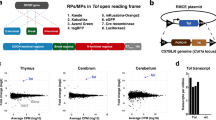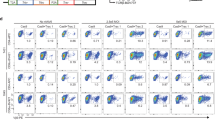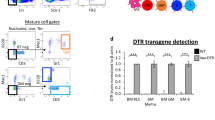Abstract
Rejection of male tissue grafts by genotypically identical female mice has been explained by the existence of a male-specific transplantation antigen, H-Y (ref. 1), but the molecular nature of H-Y antigen has remained obscure. Hya, the murine locus controlling H-Y expression, has been localized to ΔSxrb, a deletion interval of the short arm of the Y chromosome2. In mice, H–Y antigen comprises at least four distinct epitopes, each recognized by a specific T lymphocyte clone. It has recently been shown that one of these epitopes, H-YKk, is a peptide encoded by the Y-linked Smcy gene, presented at the cell surface with the H-2Kk major histocompatibility complex (MHC) molecule3. However, deletion mapping and the analysis of variable inactivation of H-Y epitopes has suggested that the Hya locus may be genetically complex4,5. Here we describe a novel mouse Y chromosome gene which we call Uty (ubiquitously transcribed tetratricopeptide repeat gene on the Y chromosome). We identify the peptide WMHHNMDLI derived from the UTY protein as an H-Y epitope, H-YDb. Our data formally demonstrate that H-Y antigen is the product of more than one gene on the Y chromosome.
This is a preview of subscription content, access via your institution
Access options
Subscribe to this journal
Receive 12 print issues and online access
$209.00 per year
only $17.42 per issue
Buy this article
- Purchase on Springer Link
- Instant access to full article PDF
Prices may be subject to local taxes which are calculated during checkout
Similar content being viewed by others
References
Echwald, E.J. & Silmser, C.R. Untitled communication. Transplant-Bull. 2, 148–149 (1955).
McLaren, A. et al. Location of the genes controlling H-Y antigen expression and testis determination on the mouse Y chromosome. Proc. Natl. Acad. Sci. USA 85, 6442–6445 (1988).
Scott, D.M. et al. Identification of a mouse male-specific antigen, H-Y. Nature 376, 695–698 (1995).
King, T.R. et al. Deletion mapping by immunoselection against the H-Y histocompatibility antigen further resolves the Sxra region of the mouse Y chromosome and reveals complexity of the Hya locus. Genomics 24, 159–168 (1994).
Scott, D., McLaren, A., Dyson, J. & Simpson, E. Variable spread of X inactivation affecting the expression of different epitopes of the Hya gene product in mouse B-cell clones. Immunogenetics 33, 54–61 (1991).
Goebl, M. & Yanagida, M. The TPR snap helix: a novel protein repeat motif from mitosis to transcription. Trends Biochem. Sci. 16, 173–177 (1991).
Smith, R.L., Redd, M.J. & Johnson, A.D. The tetratricopeptide repeats of Ssn6 interact with the homeo domain of α2. Genes Dev. 9, 2903–2910 (1995).
Lamb, J.R., Tugendreich, S. & Hieter, P. Tetratrico peptide repeat interactions: to TPR or not to TPR? Trends Biochem. Sci. 20, 257–259 (1995).
Schultz, J., Marshall-Carlson, L. & Carlson, M. The N-terminal TPR region is the functional domain of SSN6, a nuclear phosphoprotein of Saccharomyces cerevisiae. Mol. Cell. Biol. 10, 4744–4756 (1990).
Keleher, C.A., Redd, M.J., Schultz, J., Carlson, M. & Johnson, A.D. Ssn6–Tup1 is a general represser of transcription in yeast. Cell 68, 709–719 (1992).
Tjian, R. & Maniatis, T. Transcriptional activation: a complex puzzle with few easy pieces. Cell 77, 5–8 (1994).
McLaren, A., Simpson, E., Tomonari, K., Chandler, P. & Hogg, H. Male sexual differentiation in mice lacking H-Y antigen. Nature 312, 552–555 (1984).
Burgoyne, P.S. Deletion mapping the functions of the mouse Y chromosome. in Sex Chromosomes and Sex-Determining Genes (eds Reed, K.C. & Graves, J.A.M.) 353–368 (Harwood Academic Publishers, Chur, 1993).
Mitchell, M.J. & Bishop, C.E. A structural analysis of the Sxr region of the mouse Y chromosome. Genomics 12, 26–34 (1992).
Bishop, C.E., Weith, A., Mattei, M.G. & Roberts, C. Molecular aspects of sex determination in mice: an alternative model for the origin of the Sxr region. in Sex Determination in Mouse and Man (eds Maclaren, A. & Ferguson-Smith, M.A.) 119–124 (Royal Society, London, 1988).
Capel, B. et al. Deletion of Y chromosome sequences located outside the testis determining region can cause XY female sex reversal. Nature Genet. 5, 301–307 (1993).
Rammensee, H.G., Falk, K. & Rötzschke, O.A. Peptides naturally presented by MHC class I molecules. Annu. Rev. Immunol. 11, 213–244 (1993).
Schumacher, T.N.M. et al. Direct binding of peptide to empty MHC Class I molecules on intact cells and in vitro. Cell 62, 563–567 (1990).
Gavin, M.A., Dere, B., Grandea, A.G.I., Hogquist, K.A. & Bevan, M.J. Major histocompatibility complex class I allele-specific peptide libraries: identification of peptides that mimic an H-Y T cell epitope. Eur. J. Immunol. 24, 2124–2133 (1994).
Agulnik, A.I., Mitchell, M.J., Lerner, J.L., Woods, D.R. & Bishop, C.E. A mouse Y chromosome gene encoded by a region essential for spermatogenesis and expression of male-specific minor histocompatibility antigens. Hum. Mol. Genet. 3, 873–878 (1994).
Kent-First, M.G. et al. Gene sequence and evolutionary conservation of human SMCY. Nature Genet. 14, 128–129 (1996).
Agulnik, A.I. et al. A novel X gene with a widely transcribed Y-linked homologue escapes X-inactivation in mouse and human. Hum. Mol. Genet. 3, 879–884 (1994).
Sutcliffe, M.J. & Burygone, P.S. Analysis of the testes of H-Y negative XOSxrb mice suggests that the spermatogenesis gene (Spy) acts during the differentiation of the A spermatogonia. Development 107, 373–380 (1989).
Burygone, P.S. A Y-chromosomal effect on blastocyst cell number in mice. Development 117, 341–345 (1993).
Fenech, M., Carr, A.M., Murray, J., Watts, F.Z. & Lehmann, A.R. Cloning and characterisation of the rad4 gene of Schizosaccharomyces pombe; a gene showing short regions of sequence similarity to the human XRCC1 gene. Nucl. Acids Res. 19, 6737–6741 (1991).
Simpson, E., Chandler, P., Sponaas, A., Milrain, M. & Dyson, P.J. T cells with dual antigen specificity in T cell receptor transgenic mice rejecting allografts. Eur. J. Immunol. 25, 2813–2817 (1995).
Jeske, Y.W.A., Bowles, J., Greenfield, A. & Koopman, P. Expression of a linear Sry transcript in the mouse genital ridge. Nature Genet. 10, 480–482 (1995).
Koopman, P., Münsterberg, A., Capel, B., Vivian, N. & Lovell-Badge, R. Expression of a candidate sex-determining gene during mouse testis differentiation. Nature 348, 450–452 (1990).
Feinberg, A.P. & Vogelstein, B. A technique for radiolabelling DNA restriction endonuclease fragments to high specific activity. Anal. Biochem. 132, 6–13 (1983).
Sambrook, J., Fritsch, E. & Maniatis, T. Molecular Cloning: A Laboratory Manual (Cold Spring Harbor Laboratory Press, Cold Spring Harbor, New York, 1989).
Gunning, P., Leavitt, J., Muscat, G., Ng, S.-Y. & Kedes, L. A human beta-actin expression vector system directs high-level accumulation of anti-sense transcripts. Proc. Natl. Acad. Sci. USA 84, 4831–4835 (1987).
Scott, D., Dyson, P.J. & Simpson, E. A new approach to the cloning of genes encoding T cell epitopes. Immunogenetics 36, 86–94 (1992).
Author information
Authors and Affiliations
Rights and permissions
About this article
Cite this article
Greenfield, A., Scott, D., Pennisi, D. et al. An H–YDb epitope is encoded by a novel mouse Y chromosome gene. Nat Genet 14, 474–478 (1996). https://doi.org/10.1038/ng1296-474
Received:
Accepted:
Issue Date:
DOI: https://doi.org/10.1038/ng1296-474
This article is cited by
-
Alloantigen expression on malignant cells and healthy host tissue influences graft-versus-tumor reactions after allogeneic hematopoietic stem cell transplantation
Bone Marrow Transplantation (2018)
-
A primer on the use of mouse models for identifying direct sex chromosome effects that cause sex differences in non-gonadal tissues
Biology of Sex Differences (2016)
-
Distinct in vivo CD8 and CD4 T cell responses against normal and malignant tissues
Cancer Immunology, Immunotherapy (2013)
-
Mice completely lacking immunoproteasomes show major changes in antigen presentation
Nature Immunology (2012)
-
The carboxypeptidase ACE shapes the MHC class I peptide repertoire
Nature Immunology (2011)



